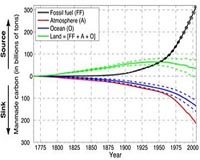| . |  |
. |
Washington (AFP) Nov 23, 2009 Thousands of animal species thrive in the ocean depths beyond the reach of sunlight, between 200 to 5,000 meters below the surface, an international team of scientists reported Sunday after nearly 10 years of research. More than 2,000 scientists from 80 countries are taking part in the first global Census of Marine Life project scheduled to be completed in October of next year. Using deep-towed cameras, sonar and other state-of-the-art technologies, the teams since 2000 have inventoried 17,650 species of marine species, ranging from crabs to shrimp to worms, living below 200 meters, the penetration limit for the sun's rays. The majority of the deep sea creatures live on animal droppings from the sunlight layer above, while others have adapted to diets of bacteria that break down oil, sulfur and methane, the sunken bones of dead whales and other foods. Edward Vanden Berghe, who manages the Ocean Biogeographic Information System (OBIS), the Census' inventory of marine life observations, said that, unsurprisingly, the number of species falls off dramatically at deeper depths. Nevertheless, he added, OBIS researchers have recorded 5,722 species living at a depth of more than 1,000 meters (yards). The scientists -- 344 from 34 countries are directly involved in the deep-sea inventory project -- said their work has shed light on the abundance, diversity and distribution of animals in marine depths that were thought to be barren. "Abundance is mostly a function of available food and decreases rapidly with depth," said Robert Carney of Louisiana State University, co-leader along with Myriam Sibuet of France of the Census project studying life along the world's continental margins. "The continental margins are where we find the transition from abundant food made by photosynthesis to darkened poverty," Carney added. He said it was difficult to understand why there was so much diversity since the silt covering the ocean bottom appears uniformly bereft of nutrients. "The transitions display the intriguing adaptations and survival strategies of amazing species," said the scientist. The most surprising creatures discovered include a "bizarre, elongated orange animal identified as Neocyema" living at 2,000 to 2,500 meters in depth. It was only the fifth specimen ever caught and the first found on the Mid-Atlantic Ridge, researchers said. At 1,000 to 3,000 meters researchers collected a very large specimen of a rare, primitive animal known as cirrate or finned octopod, commonly called "Dumbos" because they flap a pair of large ear-like fins to swim, akin to the cartoon flying elephant. The jumbo Dumbo netted by Census explorers was estimated to be nearly two meters (6.5 feet) long and, at six kilograms (13 pounds), the largest of only a few specimens of the species ever obtained. By the time the 10-year Census concludes in October, 2010, its five deep-sea projects will have collectively fielded more than 210 expeditions. The final Census report is to be released in London on October 4, 2010. Census of Marine Life can be accessed at www.coml.org. Share This Article With Planet Earth
Related Links Water News - Science, Technology and Politics
 Oceans' Uptake Of Manmade Carbon May Be Slowing
Oceans' Uptake Of Manmade Carbon May Be SlowingNew York NY (SPX) Nov 19, 2009 The oceans play a key role in regulating climate, absorbing more than a quarter of the carbon dioxide that humans put into the air. Now, the first year-by-year accounting of this mechanism during the industrial era suggests the oceans are struggling to keep up with rising emissions-a finding with potentially wide implications for future climate. The study appears in this week's issue of the jour ... read more |
|
| The content herein, unless otherwise known to be public domain, are Copyright 1995-2009 - SpaceDaily. AFP and UPI Wire Stories are copyright Agence France-Presse and United Press International. ESA Portal Reports are copyright European Space Agency. All NASA sourced material is public domain. Additional copyrights may apply in whole or part to other bona fide parties. Advertising does not imply endorsement,agreement or approval of any opinions, statements or information provided by SpaceDaily on any Web page published or hosted by SpaceDaily. Privacy Statement |